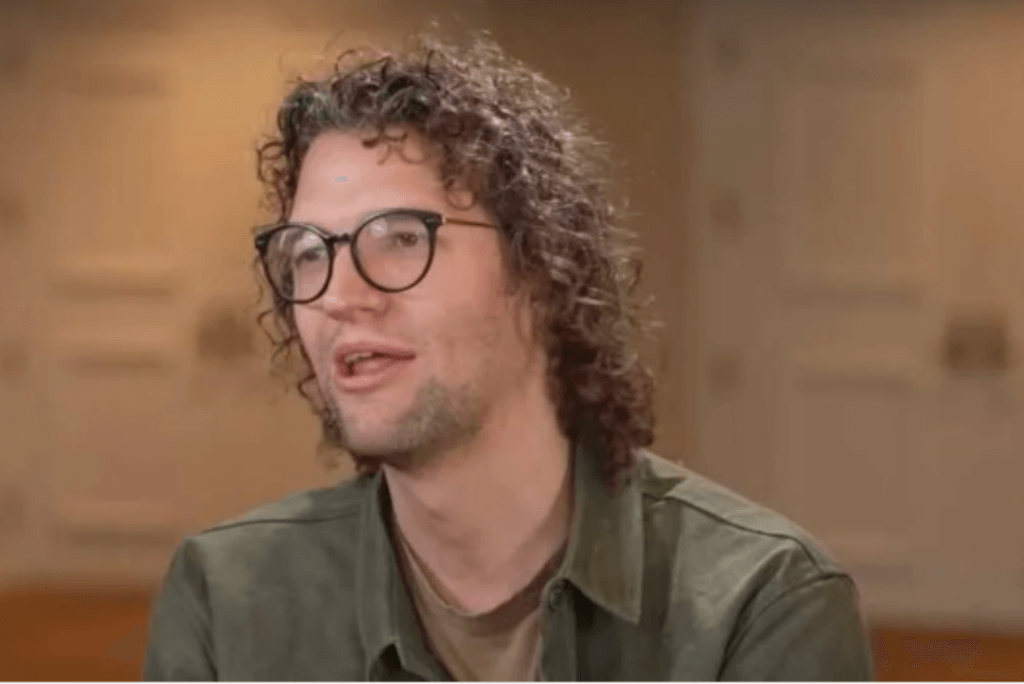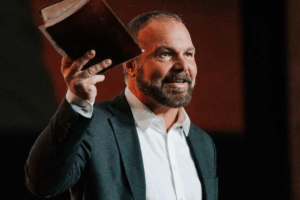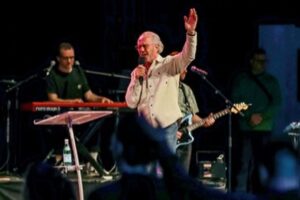The scarred intersection on Chicago’s north side was the battleground for a dozen rival street gangs. At the corner of Sheridan Road and Sunnyside Avenue, memorials marked the spot where slain gang members had fallen.
But in the space of a few weeks, the violence subsided and the trade from the drug houses disappeared.
What brought about this startling transformation? Incredibly, a piece of art-a vivid mural depicting creation’s beauty, sin’s destructive power and Jesus’ love for all races.
Artist Greg King invited neighborhood teenagers and graffiti artists to join in. The result was a striking image that won the respect of all the gang leaders. They ordered their members not to deface it.
The shootings stopped, according to Brian Bakke, a former staff member at a nearby church. “It became hallowed ground,” he told Charisma.
The mural, Bakke suggests, is evidence of something much bigger.
Across America and around the world, Holy Spirit-inspired art is piercing the darkness, bringing God’s healing touch to troubled souls and His breath of life to the spiritually dead. Christian artists are using their God-given talents to minister in the ghettos, on the beaches, in shopping malls and in prisons-everywhere people need Jesus.
“For too long, the church has neglected the imagination and the wonder of art,” comments Colin Harbinson, a leader of the growing art-in-mission movement. “This is a new day for art and the language of imagination. God is about to do something that we have only dreamt of.”
Mural painter King agrees.
“This street was the garbage can,” says the 36-year-old artist, who lives in Brooklyn, New York. “But we created a piece of beauty … an outpouring of God’s love. I think the gang members felt it.”
Bakke, former community director at Uptown Baptist just two blocks from the mural, recalls the gang leaders’ initial response to the idea. “They said: ‘If you’re gonna paint nice pictures with positive thoughts, forget it.’ We explained the mural would portray the destructive power of sin and the unity of all people in Jesus. ‘Go ahead,’ they told us. ‘Jesus is OK.'”
The intense imagery spoke to the gang members-the beauty of God’s creation wrecked by sin, symbolized by a mace shattering the world; the words “hatred,” “lust,” “racism” and “envy” springing forth; shards flying into the adjoining image of Jesus embracing all peoples.
“Most evangelical Christians are beholden to the spoken word,” says 44-year-old Bakke, a Chicago native. “But visual art is powerful, and the Holy Spirit uses our creativity.”
Messages in the Sand
Beach sculptor Randy Hofman lives for the sun, the surf and the lure of sand art. During the last 30 years, his fantastic sand sculptures have captivated hundreds of thousands of beach visitors, vacationers and partying college students.
As a kid, Hofman made sand castles like other boys. Now he spends hours crafting elaborate sand portraits of Jesus, with titles such as “God Loves You” and “Wise Men Seek Him” etched in the sand.
The images are intricate, but the message is simple. “Jesus on the cross-people get it,” says the 56-year-old from Ocean City, Maryland.
The beach is Hofman’s mission field. In the summer, 10,000 people a day view his sand sculptures along the Ocean City boardwalk. Hofman hands out gospel tracts and discusses the images with onlookers.
During spring break, Hofman joins Beach Reach, a student mission ministering to the college-age party crowd. Students swilling beer stop to admire his sculptures on South Padre Island, a party mecca off the Texas coast.
Students hit the beach late morning, often nursing hangovers. “By midafternoon, many of them are drunk again,” Hofman says.
But his sand images are a talking point for Christian students who come to mix with the revelers and converse about Jesus. In March, 70 spring breakers were led to Christ and 21 were baptized in the ocean.
“It revs me up,” Hofman told Charisma. “My job is simply to communicate God’s love to them through sand. It’s like people walking past a newspaper stand-they scan the headlines and move on. With my sculptures, people see Jesus and ‘God Loves You’ and walk on. Yet it speaks the good news that God wants us in His family.”
Art is a thread woven through the Christian experience, according to Harbinson, a recognized authority on how art fits into God’s big picture. “God is calling artists to be culture transformers,” says the 61-year-old college professor, formerly a dean at Youth With A Mission’s (YWAM’s) University of the Nations.
Many in America’s Christian mainstream misunderstand art, viewing it as a “sideshow” and failing to see artistic expression as God sees it, Harbinson says.
“Throughout the Scriptures, we see clearly that God is an artist,” he says. “Right back in Genesis 1, God created. In Exodus 31, God commissioned the first school of the arts. He chose Bezalel to make artistic designs in gold, silver, bronze and wood, including all the furnishings for the tabernacle.”
In the biblical account, God tells Moses: “I have filled [Bezalel] with the Spirit of God, in wisdom, in understanding, in knowledge, and in all manner of workmanship, to design artistic works … to work in all manner of workmanship” (Ex. 31:3-5, NKJV).
God also commissioned art to bring healing to His people, Harbinson continues, citing the story of the bronze snake in Numbers 21:4-9. In this passage, God sent venomous snakes to afflict the grumbling Israelites. Then, He commanded Moses: “‘Make a fiery serpent, and set it on a pole; and it shall be that everyone who is bitten, when he looks at it, shall live.'” Moses obeyed by crafting a snake out of bronze.
“God knows that art speaks of Him in ways that words alone cannot,” Harbinson told Charisma. “God’s very creation is nonverbal, and it speaks of Him.”
The Bible is strewn with examples of creativity and imagination, Harbinson points out, yet evangelicals in America still wrestle with “nonverbal” proclamation of the gospel and demote art’s place in God’s world.
“We are locked into thinking that it has to be ‘the spoken word’,” he observes. “We do not trust the Holy Spirit to use the image to do His work. We feel the necessity to interpret images with words. Well, Jesus is the Word, but He is also the image of God.”
Harbinson, who grew up in a strict Brethren church in England and watched his first movie at age 19, believes the tide is changing. “This generation finds it extremely difficult to sit in church and listen to a 45-minute sermon,” he says. “To put it bluntly, we are losing this generation, and we must recapture the imagination and the arts if we are to be relevant.”
Based in Jackson, Mississippi, Harbinson heads a ministry called StoneWorks that aims to break down barriers to art within the church and challenge Christian artists to engage their world.
Standing on Holy Ground
That’s what British artist Paul Hobbs is doing in England.
His Holy Ground shoe-art display is causing a stir in churches, schools, shopping malls and even at Oxford University where a chapel minister reported: “Many students and others have found it to be incredibly moving. We had 50 people praying around it this morning.” Not bad for a bunch of old shoes.
Hobbs spent two years tracking down Christians around the world whose shoes tell the stories of their inspiring journeys of faith. The 30 pairs include a former prostitute’s high-heeled stilettos, an itinerant evangelist’s worn-out sandals and the shoes of a former Muslim woman in Asia who came to faith in Christ through a vision of Jesus.
Hobbs, 44, who lives in southern England, came up with the idea after receiving a vision from the Holy Spirit while in prayer. He pictured shoes of all types, along with bare feet, and sensed Moses’ encounter with God, when Moses removed his sandals because he was on “holy ground.”
Hobbs sets up the art display in a circle on the floor, so that people can walk around it, looking at the shoes and reading the stories that accompany them. Hobbs’ favorite pair is the unique sandals of an African evangelist who treks miles on foot and is often persecuted and beaten for the gospel’s sake. The sandals-made out of old rubber tires-still have mud on the soles.
Perhaps the most emotive “shoe story” is told by Rosemarie’s shoes. Rosemarie’s father was Adolf Hitler’s bodyguard for the 1936 Olympic Games, and Hitler was her godfather. Her dad-a Christian-risked his life to help persecuted Jews escape Nazi Germany before World War II. In 1938, he was forced to swallow a cyanide pill.
Many people slip off their own shoes as a sign of respect as they circle Holy Ground. In one shopping center, hundreds of people stopped to look-including Muslims who appreciated the custom of going barefoot.
“I often wonder what Muslims make of it,” Hobbs admits.
For many, Holy Ground is an emotional experience. “I’ve seen people in tears … some sobbing,” Hobbs says. Sometimes, people are convicted about their own lukewarm walk with Christ and their need to run a strong race of faith.
One little girl, Hobbs recalls, came to view the display every day of the exhibition and asked her parents to read her a different story each time. Examples like this, Hobbs says, demonstrate that the Holy Spirit uses art He has inspired to probe the hearts and minds of young and old alike, crossing generational, cultural and racial lines.
Healing Through Art
Marge Malwitz, a Connecticut-based quilter, found this to be true when, through the ministry of World Relief, she took her artwork to a group of genocide survivors in Rwanda. The women-mostly widows who lost their husbands in the ethnic bloodshed of 1994-were skeptical when they heard an American artist was coming to share with them about pain, reconciliation and healing.
What does she know about the pain of genocide? wondered Rose Busingye, one of the women. Yet as Malwitz showed the women her quilt designs and discussed the imagery of darkness, bitterness and despair giving way to light and hope in Christ, Busingye and others softened.
“I was proved wrong,” Busingye admits. “This down-to-earth lady began to talk about her journey of pain, depression and hopelessness. She explained how God transformed and restored her life. ‘God wastes nothing,’ she told us. The Holy Spirit was using her art to bring healing to us.”
Malwitz, a 60-year-old grandmother, used her quilt art to share her own story about how God rescued her from a “dark pit.” Slowly, the Rwandan women began to talk for the first time about their web of hidden heartaches spun by the horrors of the genocide.
“It was as if a veil lifted,” Busingye recalls.
The women wept as they confessed their grudges and asked one another’s forgiveness. The quilt art, Busingye says, was the key to opening the floodgates of healing and restoration. “The Spirit of God was at work,” she says. “He tore down the walls.”
Malwitz’s philosophy is simple. “I give God my art, He provides the venue and the Holy Spirit does His work,” she told Charisma. “I don’t preach. The quilts tell the story.”
Says Malwitz: “People are looking at a piece of art and talking about something that is removed from them, yet they are really talking about their own situation. They are pointing at the quilt, but they are really pointing at themselves.”
Malwitz is not alone in using art to communicate God’s love and healing across continents and cultures. A growing number of Christian agencies, including World Relief, Operation Mobilization (OM) and YWAM, embrace the use of Holy Spirit-inspired art. Through OM’s ArtsLink and other cutting-edge missions, a new breed of “art missionary” is emerging-artists who are not afraid to take their visual message to the darkest, most oppressive corners of the earth.
Paula Dubill enters prisons to share Christ’s love with violent offenders and rapists through her artwork. “My heart is for those in prison, refugees and the displaced,” explains the 48-year-old YWAM missionary-artist. Based out of Hawaii and Virginia, Dubill travels the world, often ministering in war zones and hostile areas.
“My heroes were Brother Andrew and Corrie ten Boom,” she says. “At first, no one seemed to want an art missionary.”
YWAM opened the door.
In a prison in South Africa, Dubill staged art classes for violent criminals. Patrick came to class with the words “Son of Satan” tattooed on his forehead. As Dubill sketched his portrait, Patrick told her he had AIDS, syphilis and tuberculosis. When it was the inmates’ turn to create, Patrick made a clay tombstone inscribed with “R.I.P.”
“All I could think when I saw it was that there was a spirit of death over him,” Dubill recalls.
Another missionary-once a member of a satanic church-counseled Patrick that only the Holy Spirit could transform his image of death into a glorious image of new life. A few days later, Patrick bowed to his Creator and became a son of God.
Patrick’s story is a mosaic of brokenness and marvelous restoration. A portrait of God’s amazing grace. A tapestry of the Holy Spirit’s gentle wooing. It is proof that our Creator is a God of art. —Julian Lukins
ONLINE EXCLUSIVE: Find information about other artists who are making an impact for the kingdom of God here.
This article is from the December 2008 issue of Charisma
See an error in this article?
To contact us or to submit an article





















